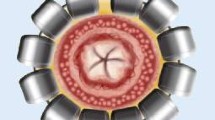Abstract
The problem of fecal incontinence is growing due to an array of causes; it can follow trauma (childbirth), surgery, or be from neurological origin, or other. Over the last century, multiple surgical therapies have been suggested and tried including injection of biomaterials into the anal canal, radiofrequency treatment of the anal canal, repair of anal muscle injuries, sacral nerve stimulation, artificial bowel sphincter, muscle transposition to reinforce the anal sphincter, and creation of a stoma in last resort.
Magnets have been introduced in the last two decades to palliate this problem; however, some have abandoned due to problems of erosions and migrations. Recently, we have seen a resurgence in using a new type of magnets assembly; the literature is reviewed here, including some recent comparisons to other treatments for fecal incontinence.
Access this chapter
Tax calculation will be finalised at checkout
Purchases are for personal use only
Similar content being viewed by others
References
Bortolotti M. The magnetic anal sphincter: a seductive promise still not kept. Color Dis. 2015;17(1):89–90.
Lehur PA, Barussaud ML. The magnetic anal sphincter: a seductive promise still not kept. Color Dis. 2015;17(5):452.
Bortolotti M, Ugolini G, Grandis A, et al. A novel magnetic device to prevent fecal incontinence (preliminary study). Int J Color Dis. 2008;23:499–501.
Mantoo S, Meurette G, Podevin J, Lehur PA. The magnetic anal sphincter: a new device in the management of severe fecal incontinence. Expert Rev Med Devices. 2012;9(5):483–90.
Sugrue J, Lehur PA, Madoff RD, et al. Long-term experience of magnetic anal sphincter augmentation in patients with fecal incontinence. Dis Colon Rectum. 2017;60(1):87–95.
Kim M, Lehur PA. How to size the anal canal circumference when implanting a magnetic anal sphincter for fecal incontinence. Evolution and update of a new surgical technique. Dis Colon Rectum. 2016;59(9):901–3.
Barussaud ML, Mantoo S, Wyart V, Meurette G, Lehur PA. The magnetic anal sphincter in faecal incontinence: is initial success sustained over time? Color Dis. 2013;15(12):1499–503.
Wong MT, Meurette G, Wyart V, Glemain P, Lehur PA. The artificial bowel sphincter: a single institution experience over a decade. Ann Surg. 2011;254(6):951–6.
Wong MT, Meurette G, Stangherlin P, Lehur PA. The magnetic anal sphincter versus the artificial bowel sphincter: a comparison of 2 treatments for fecal incontinence. Dis Colon Rectum. 2011;54(7):773–9.
Wong MT, Meurette G, Wyart V, Lehur PA. Does the magnetic anal sphincter device compare favourably with sacral nerve stimulation in the management of faecal incontinence? Color Dis. 2012;14(6):e323–9.
Lehur PA, McNevin S, Buntzen S, Mellgren AF, Laurberg S, Madoff RD. Magnetic anal sphincter augmentation for the treatment of fecal incontinence: a preliminary report from a feasibility study. Dis Colon Rectum. 2010;53(12):1604–10.
Lehur PA. The anal artificial sphincter in severe anal incontinence. Int J Surg Investig. 1999;1(3):268–9.
Faucheron JL, Sage PY, Trilling B. Erosion rate of the magnetic sphincter augmentation device is much higher for anal incontinence than for antireflux. J Gastrointest Surg. 2019;23(2):389–90.
Alicuben ET, Bell RCW, Jobe BA, et al. Worldwide experience with erosion of the magnetic sphincter augmentation device. J Gastrointest Surg. 2018;22(8):1442–7.
Williams AE, Croft J, Napp V, et al. SaFaRI: sacral nerve stimulation versus the FENIX magnetic sphincter augmentation for adult faecal incontinence: a randomised investigation. Int J Color Dis. 2016;31(2):465–72.
DeStephano CC, Chen AH, Pettit PD. The Fenix system for fecal incontinence: an overview and surgical demonstration. J Minim Invasive Gynecol. 2017;24(7):1078.
Espinal M, DeStephano CC, Guha P, Gajarawala SP, Chen AH, Pettit PD. Robotic placement of the FENIX continence restoration system in a patient with previous radiation to the pelvis: a case report. J Minim Invasive Gynecol. 2018;25(3):528–32.
Stokes WE, Jayne DG, Alazmani A, Culmer PR. A biomechanical model of the human defecatory system to investigate mechanisms of continence. Proc Inst Mech Eng H. 2019;233(1):114–26.
US Food and Drug Administration. Humanitarian device exemption (HDE). FENIX® Continence Restoration System. The summary of safety and effectiveness data. https://www.accessdata.fda.gov/cdrh_docs/pdf13/H130006b.pdf
Lehur PA, Christoforidis D, Meurette G. Artificial sphincters to treat severe fecal incontinence: currently in a deadlock. Dis Colon Rectum. 2020;63(8):1017–9.
Thomas G, Vaizey C. Surgery. In: Collins B, Bradshaw E, editors. Bowel dysfunction. Cham.: Springer; 2016. p. 225–39. https://doi.org/10.1007/978-3-319-43214-4_14.
Author information
Authors and Affiliations
Editor information
Editors and Affiliations
Rights and permissions
Copyright information
© 2021 Springer Nature Switzerland AG
About this chapter
Cite this chapter
Gagner, M. (2021). Magnetic Anal Sphincter for Fecal Incontinence. In: Gagner, M. (eds) Magnetic Surgery. Springer, Cham. https://doi.org/10.1007/978-3-030-73947-8_18
Download citation
DOI: https://doi.org/10.1007/978-3-030-73947-8_18
Published:
Publisher Name: Springer, Cham
Print ISBN: 978-3-030-73946-1
Online ISBN: 978-3-030-73947-8
eBook Packages: MedicineMedicine (R0)




